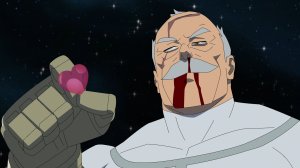
After months of teasers, Marvel published the final chapter of its Death of Wolverine miniseries today, which, as the title of the book states, is expected to remove the Canadian mutant from the Marvel Comics Universe for a chunk of time.
Videos by ComicBook.com
Going back to his very first appearance in Incredible Hulk #180, Wolverine has enjoyed a special place in the Marvel pantheon as one of its most popular (and some might argue, overexposed) heroes. Between his exploits with the X-Men, and in his own solo titles, the character has been written and illustrated by some of the industry’s brightest stars, including Chris Claremont, John Byrne, Frank Miller, Mark Millar, Steve McNiven and John Buscema.
To jumpstart all of the Wolverine eulogizing that will be going on throughout the Marvel U. over the next few weeks/months, we thought it would be appropriate the celebrate the very best Wolverine stories and moments since the character debuted 40 years ago.

10. “Old Man Logan” (Wolverine vol. 3 #66-72, Wolverine Giant Size Old Man Logan)
Not for the faint of heart or weak of stomach, Mark Millar and Steve McNiven collaborate to bring Wolverine into a violent, dystopian future where all of Marvel’s supervillains have banded together to destroy superheroes and rule the world in individual fiefdoms. In this story, Logan has renounced his former persona as Wolverine. The reader eventually discovers that Wolverine “died” the day Logan was tricked by the villain Mysterio into thinking he was attacking a gang of villains invading the X-Mansion, when in reality, Wolverine was hacking and killing his X-Men teammates.
Logan is eventually goaded back into becoming Wolverine when his family is murdered by the incestuous ancestors of the Hulk/She-Hulk. That leads to an absolutely brutal fight between the two long-time rivals in Wolverine and Hulk.
“Old Man Logo” is bombastic and filled with copious amount of blood and guts, but it’s also quite riveting and enthralling, making it one of the more memorable Wolverine solo stories to ever be published.

9. “Coyote Crossing” (Wolverine vol. 3 #7-11)
As the second major arc in Greg Rucka’s run scripting Wolverine, “Coyote Crossing,” is a noticeably quieter, more methodically paced story that is far more character-centric than a number of other entries that will appear on this list. The story follows Wolverine as he’s tracking down a mysterious leader of a gang involved in human trafficking near the Mexican border. Meanwhile, Wolverine is getting tailed himself by a DEA agent Rucka introduced earlier in the series, Cassandra Lathrop.
Wolverine is ultimately faced with a choice where he needs to decide between giving in to his base animal instincts, or empathizing with his cruel adversary and demonstrating his humanity. The Wolverine character is always at his richest and most complex when faced with the kind of moral dilemma Rucka raises in this story.

8. “Fatal Attractions” (mainly X-Men #25 and Wolverine #75)
Because every major comic book character needed a big game-changing, status quo-upheaving moment during the 1990s. In Wolverine’s case, “Fatal Attractions” is the storyline where Magneto uses his mastery of magnetism to pull the adamantium coating off of Wolvie’s skeleton. Why Magneto had never thought of that before over the previous 15 years remains one of life’s great mysteries.
In the following issue of the “Fatal Attractions” arc, while Wolverine is recovering from his horrific injuries, the X-Men learn that their teammate actually has bone claws – meaning they were a part of his skeleton. Wolverine’s portion of “Fatal Attractions” end with Logan leaving a bunch of “Dear John” letters for his teammates, and taking off to figure stuff out on his own for a while.
Despite some of the plotholes and over-the-top 90s-ness of the arc (reportedly Peter David suggested that Magneto remove Wolverine’s adamantium as a joke), “Fatal Attractions” went on to be one of the most popular and memorable arcs from the decade, with fans still talking about the Magneto/Wolverine showdown to this day.

7. Origin
This six-part miniseries, which was written by Bill Jemas, Paul Jenkins and Joe Quesada, with art from Andy Kubert, finally establishes some semblance of a origin story for Wolverine, focusing on the character in his earliest days as a child living on a plantation. There are still some things about the character that are left unexplained by the comic – though the creative team would later admit that this was explicitly by design as a way to keep one of their most popular character somewhat shrouded in mystery.
The series also does a really slick job in creating analogues of key characters in Wolverine’s life. One character, a young boy named Dog, is clearly inspired by longtime Wolverine adversary, Sabertooth, to the point that some people don’t even think the child is “inspired” on the character that he actually IS Sabertooth. Additionally, there are parallels with two characters and Scott Summers (Cyclops) and Jean Grey, which provide context as to why Wolverine acts the way he does as an adult. A sequel to Origin was released earlier this year from the Kieron Gillen and Adam Kubert creative team.

6. Kitty Pryde and Wolverine
This 1984-85 miniseries from Chris Claremont and Al Milgrom is as critical to the young Kitty Pryde’s biography as it is to Wolverine’s. In one of mini’s collected editions, Milgrom says that the impetus behind the series was Wolverine’s white hot popularity and Claremont’s desire to raise the profile of Pryde – a character that he had created and was very passionate about.
With that in mind, Kitty is depicted as being a bit more hardened and troubled in this story when compared to how she was being portrayed in the larger X-Men group setting. Additionally, this is one of the first stories that established Wolverine’s parental/familial sensibilities – a trope that would be repeated numerous times over with Logan and other younger female members of the X-family.
Probably the greatest part of this miniseries is the fact that Claremont and other creators maintained that mentor/protégé relationship between Wolverine and Kitty, while also allowing both characters to mature and evolve. It’s the sincerity and authenticity of this relationship that makes the Wolverine/Kitty dynamic is one of the very best in the X-Men universe.

5. “24 Hours” (Wolverine vol. 2 #10)
This phenomenal one-and-done story from creative masters Chris Claremont and John Buscema weaves between past and present to ultimately depict the cyclical nature of Wolverine and Sabertooth’s violent, hate-fueled relationship. The story takes place on Wolverine’s birthday as he remembers his first brutal fight with Sabertooth many years earlier on the same day. Sabertooth’s dominance over Wolverine causes the character to realize what it’s like to be beaten, and to know fear and pain. Seeing this level of vulnerability and weakness from a “tough-guy” character like Wolverine is quite shocking and unsettling. Meanwhile, this story absolutely confirms that Sabertooth is Wolverine’s arch-nemesis, especially with its surprise (and clever) ending involving a note that is left behind for Wolverine.
Elements of the story would be mined considerably for 2009’s X-Men Origins: Wolverine film, demonstrating just how influential “24 Hours” ended up being for the character and the X-Family comic book universe.

4. “Enemy of the State” (Wolverine #20-31)
This Hollywood-style epic, courtesy of Mark Millar and John Romita Jr., shows the danger posed by a not-in-the-right-mind Wolverine, who is killed in one of the arc’s first chapters and resurrected and brainwashed as an agent of the Hand and Hydra. Under the guidance of these two evil terrorist organizations, Wolverine goes on the mother of all killing sprees, taking out friends and allies in the process. Nearly every major Marvel hero and faction of note makes an appearance in this arc, lending to its overall event feel. In the story’s second half, Nick Fury and S.H.I.E.L.D. work to bring Wolverine back from the dark side – before their hands are forced and they have to send him out into action to fight Hydra and their new leader, the mutant Gorgon.
What the story lacks in nuance, it makes up for in spades in terms of its scope and excitement. That’s why “Enemy of the State” is unmistakably an achievement from two, top-of-their-game creators in Millar and JRJR, who certainly give the storyline the right amount of glitz and verve.

3. “Wolverine: Alone” (X-Men #132)
Considering the previous issue of X-Men ended with one of the greatest moments in Wolverine history – Wolverine pulling himself out of the muck, promising to take his “best shot” at the rogues who threw him down there and left him for dead – it’s rather elementary for the follow-up to appear on this list somehow. This comic is actually one chapter of the larger “Dark Phoenix Saga,” arguably the greatest X-Men story of all time, but it’s also the undisputed coming out party for everyone’s favorite Canucklehead.
With all of his other teammates captured or out of commission thanks to the Hellfire Club and the brainwashed Jean Grey, Wolverine is charged with making his way through the Hellfire Club mansion in order to save the other X-Men. In the comic’s opening sequence, Wolverine is hiding in the rafters like he’s Spider-Man, waiting to get the drop on his opponents.
Wolverine uses equal doses of guil and brute force to work his way back to his teammates. And even when he has a gun pointing directly to his temple, he still keeps finding ways to slip by his enemies. With X-Men #131’s final panel and this entire issue, Chris Claremont and John Byrne made it “cool” to like Wolverine – a feeling that has followed the character for the next 30-plus years.

2. “Weapon X” (Marvel Comics Presents #72-84)
This haunting and horrifying storyline, which was written and illustrated by Barry Windsor-Smith, was the first real attempt to explain elements of Wolverine’s mysterious, sometimes convoluted origin.
Windsor-Smith tells his story primarily from the perspective of three members of the “Weapon X” team – a clandestine program that takes “subjects” and bonds the unbreakable substance adamantium to their skeletons, resulting in ultimate killing machines.
The abuse and torture Wolverine is subjected to throughout the arc is often uncomfortable to read, but it also goes a long way in terms of explaining the character’s quirks and idiosyncrasies. Windsor-Smith also borrows a number of narrative devices and tropes from the horror movie/slasher film genre, which makes the comic read almost like an edgier version of an old pulp magazine.

1. Wolverine
The four-part miniseries that took a red hot Wolverine and made him reach supernova status in the comic book industry. It also brought together the creative dream team of Chris Claremont on script and Frank Miller on pencils, who produce such a wholly unique and visually ambitious story that many consider it one of the more influential comics from the past 30-plus years.
In an effort to truly define Wolverine as a separate entity from his X-Men teammates, Wolverine is set primarily in Japan, and places the hero in a world of ninja, samurais and organized crime. Despite this vast departure from X-Men, Wolverine introduces countless themes and character developments that have stuck with the character for the years that followed. It even marks the first appearance of Wolverine’s classic catchphrase, “I’m the best there is at what I do.” Those who saw 2013’s The Wolverine film should note that numerous elements of the movie are adapted from this comic.









